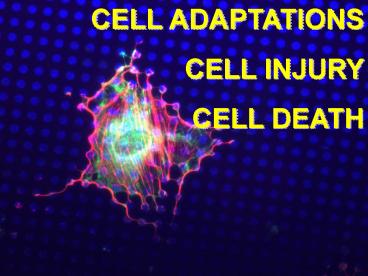OBJECTIVES - PowerPoint PPT Presentation
1 / 65
Title:
OBJECTIVES
Description:
Caseous (cheese) (Tuberculosis) Fat (Breast, any fat, usually due to trauma) ... CASEOUS NECROSIS, TB. FIBRINOID NECROSIS 'WET' GANGRENE 'DRY' GANGRENE ... – PowerPoint PPT presentation
Number of Views:55
Avg rating:3.0/5.0
Title: OBJECTIVES
1
CELL ADAPTATIONS CELL INJURY CELL DEATH
2
OBJECTIVES
Understand the 3 main anatomic concepts of
disease---Degenerative, Inflammatory,
Neoplastic Understand the concepts of cellular
growth adaptations---Hyperplasia, Hypertrophy,
Atrophy, Metaplasia Understand the factors of
cell injury and death---O2, Physical, Chemical,
Infection, Immunologic, Genetic, Nutritional
3
OBJECTIVES
- Understand the pathologic mechanisms at the
SUB-cellular level---ATP, Mitochondria, Ca,
Free Radicals, Membranes - Understand and differentiate the concepts of
APOPTOSIS and NECROSIS - Understand SUB-cellular responses to
injury---Lysosomes, Smooth endoplasmic reticulum,
Mitochondria, Cytoskeleton
4
OBJECTIVES
- Identify common INTRA-cellular accumulations---Fa
t, Hyaline, CA, Proteins, Glycogen, Pigments - Understand aging and differentiate the concepts
of preprogrammed death versus wear and tear.
5
PATHOLOGY
Pathos (suffering) Logos
6
PATHOLOGY
- GENERAL
- SYSTEMIC
7
PATHOLOGY
- ETIOLOGY (Cause)
- PATHOGENESIS (Insidious development)
- MORPHOLOGY (ABNORMAL ANATOMY)
- CLINICAL EXPRESSION
8
ETIOLOGY
- Cause
- vs.
- Risk Factors
9
PATHOGENESIS
- sequence of events from the initial stimulus to
the ultimate expression of the disease
10
MORPHOLOGY
- Abnormal Anatomy
- Gross
- Microscopic
- Radiologic
- Molecular
11
Most long term students of pathology, like
myself, will strongly agree that the very best
way for most minds to remember, or identify, or
understand a disease is to associate it with a
morphologic IMAGE. This can be gross, electron
microscopic, light microscopic, radiologic, or
molecular. In MOST cases it is at the LIGHT
MICROSCOPIC LEVEL.
12
CLINICAL/FUNCTIONAL
Rudolph Virchow 1821-1902 The Father of Modern
Pathology
13
FUNCTIONAL DEFINITION OF DISEASE
HOMEOSTASIS
14
CELL DEATH
- APOPTOSIS (normal death)
- NECROSIS (premature or untimely death due to
causes
15
The plasia brothers
- HYPER-
- HYPO- (A-)
- NORMO-
- META-
- DYS-
- ANA-
- Frank ANA-
16
HYPER-PLASIA
IN-CREASE IN NUMBER OF CELLS
17
HYPO-PLASIA
DE-CREASE IN NUMBER OF CELLS
18
The trophy brothers
- HYPER-
- HYPO- (A-)
- DYS-
19
HYPER-TROPHY
IN-CREASE IN SIZE OF CELLS
20
HYPO-TROPHY?
DE-CREASE IN SIZE OF CELLS?
RARELY USED TERM
21
A-TROPHY?
DE-CREASE IN SIZE OF CELLS? YES
SHRINKAGE IN CELL SIZE DUE TO LOSS OF CELL
SUBSTANCE
22
ATROPHY
- DECREASED WORKLOAD
- DENERVATION
- DECREASED BLOOD FLOW
- DECREASED NUTRITION
- AGING (involution)
- PRESSURE
23
METAPLASIA
- A SUBSTITUTION of one NORMAL CELL or TISSUE type,
for ANOTHER - COLUMNAR? SQUAMOUS (Cervix)
- SQUAMOUS? COLUMNAR (Glandular) (Stomach)
- FIBROUS? BONE
- WHY?
24
CELL DEATH
- APOPTOSIS vs. NECROSIS
- What is DEATH? (What is LIFE?)
- DEATH is IRREVERSIBLE
25
So the question is.
NOT what is life or death, but what is
REVERSIBLE or IRREVERSIBLE injury
26
REVERSIBLE CHANGES
- REDUCED oxidative phosphorylation
- ATP depletion
- Cellular SWELLING
27
IRREVERSIBLE CHANGES
- MITOCHONDRIAL IRREVERSIBILITY
- IRREVERSIBLE MEMBRANE DEFECTS
- LYSOSOMAL DIGESTION
28
REVERSIBLE INJURY IRREVERSIBLE DEATH SOME
INJURIES CAN LEAD TO DEATH IF PROLONGED and/or
SEVERE enough
29
INJURY CAUSES (REVERSIBLE)
THE USUAL SUSPECTS
ButWHO are the THREE WORST?
30
INJURY CAUSES (REVERSIBLE)
Hypoxia, (decreased O2) PHYSICAL Agents CHEMICAL
Agents INFECTIOUS Agents Immunologic Genetic Nutri
tional
31
INJURY MECHANISMS (REVERSIBLE)
DECREASED ATP MITOCHONDRIAL DAMAGE INCREASED
INTRACELLULAR CALCIUM INCREASED FREE
RADICALS INCREASED CELL MEMBRANE PERMEABILITY
32
What is Death?What is Life?
- DEATH is
- IRREVERSIBLE MITOCHONDRIAL DYSFUNCTION
- PROFOUND MEMBRANE DISTURBANCES
- LIFE is..???
33
CONTINUUM
- REVERSIBLE ?
- IRREVERSIBLE?
- DEATH?
- EM?
- LIGHT MICROSCOPY?
- GROSS APPEARANCES
34
DEATHELECTRON MICROSCOPY
35
DEATHLIGHT MICROSCOPY
36
NECROSIS BROTHERS
- Liquefactive (Brain)
- Gangrenous (Extremities, Bowel, non-specific)
- WET
- DRY
- Fibrinoid (Rheumatoid, non-specific)
- Caseous (cheese) (Tuberculosis)
- Fat (Breast, any fat)
- Ischemic (non-specific)
- Avascular (aseptic), radiation, organ specific,
papillary - YAHOO!
37
LIQUEFACTIVE NECROSIS, BRAIN
38
MORE LIQUID ? MORE WATER ? MORE PROTONS
39
CASEOUS NECROSIS, TB
40
FIBRINOID NECROSIS
41
WET GANGRENE
42
DRY GANGRENE
43
EXAMPLES of Cell INJURY/NECROSIS
- Ischemic (Hypoxic)
- Ischemia/Reperfusion
- Chemical
44
ISCHEMIC INJURY
- REVERSIBLE? IRREVERSIBLE
- DEATH (INFARCT)
45
ISCHEMIA/RE-PERFUSION INJURY
NEW Damage Theory
46
CHEMICAL INJURY
- Toxic Chemicals, e.g CCl4
- Drugs, e.g tylenol
- Dose Relationship
- Free radicals, organelle, DNA damage
47
APOPTOSIS
- NORMAL (preprogrammed)
- PATHOLOGIC (associated with Necrosis)
48
NORMAL APOPTOSIS
- Embryogenesis
- Hormonal Involution
- Cell population control, e.g., crypts
- Post Inflammatory Clean-up
- Elimination of HARMFUL cells
- Cytotoxic T-Cells cleaning up
49
PATHOLOGIC APOPTOSIS
- Toxic effect on cells, e.g., chemicals,
pathogens - Duct obstruction
- Tumor cells
- Apoptosis/Necrosis spectrum
50
APOPTOSIS MORPHOLOGY
- DE-crease in cell size, i.e., shrinkage
- IN-crease in chromatin concentration, i.e.,
hyperchromasia, pyknosis? karyorhexis? karyolysis - IN-crease in membrane blebs
- Phagocytosis
51
SHRINKAGE/HYPERCHROMASIA
52
PHAGOCYTOSIS
53
APOPTOSIS BIOCHEMISTRY
- Protein Digestion (Caspases)
- DNA breakdown
- Phagocytic Recognition
54
SUB-Cellular Responses to Injury(APOPTOSIS/NECROS
IS)
- Lysosomal Auto-Digestion
- Smooth Endoplasmic Reticulum (SER) activation
- Mitochondrial SWELLING
- Cytoskeleton Breakdown
- Thin Filaments (actin, myosin)
- Microtubules
- Intermediate Filaments (keratin, desmin,
vimentin, neurofilaments, glial filaments)
55
INTRAcellular ACCUMULATIONS
- Lipids
- Neutral Fat
- Cholesterol
- Hyaline any proteinaceous pink glassy
substance - Glycogen
- Pigments (EX-ogenous, END-ogenous)
- Calcium
56
LIPID LAW
- ALL Lipids are YELLOW grossly and WASHED out
(CLEAR) microscopically
57
FATTY LIVER
58
FATTY LIVER
59
(No Transcript)
60
PIGMENTS
EX-ogenous--- (tattoo, Anthracosis) END-ogenous---
they all look the same, (e.g., hemosiderin,
melanin, lipofucsin, bile), in that hey are all
golden yellowish brown on routine Hematoxylin
Eosin (HE) stains
61
TATTOO, MICROSCOPIC
62
ANTHRACOSIS
63
Hemosiderin/Melanin/etc.
64
CALCIFICATION
- DYSTROPHIC (LOCAL CAUSES) (often with FIBROSIS)
- METASTATIC (SYSTEMIC CAUSES)
- HYPERPARATHYROIDISM
- METASTATIC Disease
NOT to be confused with metastatic
calcification
65
CELL AGING parallels ORGANISMAL AGING
PROGRAMMED THEORY (80) vs. WEAR AND TEAR THEORY
(20)

